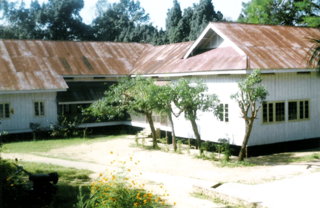Related Research Articles

Meghalaya is a state in Northeast India. Meghalaya was formed by carving out two districts from the state of Assam: the United Khasi Hills and Jaintia Hills, and the Garo Hills on 21 January 1972. The population of Meghalaya as of 2016 is estimated to be 3,211,474. Meghalaya covers an area of approximately 22,430 square kilometres, with a length-to-breadth ratio of about 3:1.
Kokborok (Tripuri/Tiprakok) is the main native language of the Tripuri people of the Indian state of Tripura and neighbouring areas of Bangladesh. Its name comes from kok meaning "verbal" and borok meaning "people" or "human". Kokborok or Tripuri is one of the ancient language of North East India.

West Garo Hills is an administrative district in Garo Hills of the state of Meghalaya in India. Tura town is the administrative headquarters of the district. The district occupies an area of 3714 km². In 2011 its population was 643,291. As of 2011 it is the second most populous district of Meghalaya, after East Khasi Hills.

The Garos are an indigenous Tibeto-Burman ethnic group from the Indian subcontinent, notably found in the Indian states of Meghalaya, Assam, Tripura, Nagaland, and some neighboring areas of Bangladesh, notably Mymensingh, Netrokona, Jamalpur, Sherpur and Sylhet, Rangamati who call themselves A·chik Mande or simply A·chik or Mande - the name "Garo" being given to them and used by non-Garos. Historically, Garo name was used for wide range of people in southern bank of Brahmaputra but today, Garo means Hill tribes who call themselves A'chik or Mande. They are the second-largest tribe in Meghalaya after the Khasi and comprise about a third of the local population. The Garos are one of the few remaining matrilineal societies in the world.

The Garo Hills are part of the Garo-Khasi range in Meghalaya, India. They are inhabited mainly by tribal dwellers, the majority of whom are Garo people. It is one of the wettest places in the world. The range is part of the Meghalaya subtropical forests ecoregion.
Koch is a Sino-Tibetan language spoken by the Koch people of Republic of India and Koch people in Nepal, Bhutan and Bangladesh.
Garo, or A·chikku, is a Sino-Tibetan language spoken in India in the Garo Hills districts of Meghalaya, some parts of Assam, and in small pockets in Tripura. It is also spoken in certain areas of the neighbouring Bangladesh. According to the 2001 census, there are about 889,000 Garo speakers in India alone; another 130,000 are found in Bangladesh.
The indigenous people of Bangladesh refer to ethnic minorities in Chittagong Hill Tracts (southeastern), Sylhet Division (northeastern), Rajshahi Division (northwestern), and Mymensingh District (north-central) areas of the country. The total population of indigenous ethnic minorities in Bangladesh was estimated to be over 2 million in 2010. They are diverse ethnic communities including Tibeto-Burman, Austric and Dravidian people.
Hajong is an Indo-Aryan language with a possible Tibeto-Burman language substratum. It is spoken by approximately 80,000 ethnic Hajongs across the northeast of the Indian subcontinent, specifically in the states of Assam, Meghalaya, Arunachal Pradesh, and West Bengal in present-day India, and the divisions of Mymensingh and Sylhet in present-day Bangladesh. It is written in Bengali-Assamese script and Latin script. It has many Sanskrit loanwords. The Hajongs originally spoke a Tibeto-Burman language, but it later mixed with Assamese and Bengali.
The Sal languages are a branch of Sino-Tibetan languages spoken in eastern India, parts of Bangladesh, and Burma.
The Boro–Garo languages are a branch of Sino-Tibetan languages, spoken primarily in Northeast India and parts of Bangladesh.
The Boroic languages are a group of Sino-Tibetan languages spoken in northeastern India. They are:

Bangladeshis are the citizens of Bangladesh, a South Asian country centered on the transnational historical region of Bengal along the eponymous bay.

The Christian Girls Higher Secondary School is a secondary school in Tura, Meghalaya, India. It is one of the oldest schools in the state of Meghalaya, as well as in the whole of the north-east of India. It was established in 1920, in its present location. The history of its formation dates back to 1874. "Wangala", the traditional dance form of "the Garos" is taught as part of the school curriculum.

The Hajong are a tribal group native to the Indian subcontinent, notably in the northeast Indian states and Bangladesh. The majority of the Hajongs are settled in India. Hajongs are predominantly rice farmers. They are said to have brought wet-field cultivation to Garo Hills, where the Garo people used slash and burn method of agriculture. Hajong have the status of a Scheduled Tribe in India.
Megam is a Sino-Tibetan language spoken in Kalmakanda subdistrict, Netrokona district, Mymensingh division, Bangladesh. It is most closely related to Garo, but has been strongly influenced by Khasian languages, to the extent that it is only 7–9% lexically similar to with A’beng, the neighboring Garo dialect, but 60% similar to the Khasian language Lyngngam.
Rabha is a Tibeto-Burman language of India, Bhutan,Nepal and Bangladesh. The two dialects, Mayturi and Rongdani, are divergent enough to cause problems in communication. According to U.V. Jose, there are three dialects, viz. Róngdani or Róngdania, Mayturi or Mayturia and Songga or Kocha. Jose writes that "the Kocha dialect, spoken along the northern bank of the Brahmaputra, is highly divergent and is not intelligible to a Róngdani or Mayturi speaker". Jose also writes that "[t]he dialect variations between Róngdani and Mayturi, both of which are spoken on the southern bank of the Brahmaputra, in the Goalpara district of Assam and belong to the northern slopes of Meghalaya, are minimal". He concludes the paragraph on dialectal variation with: "The Róngdani-Mayturi dialectal differences become gradually more marked as one moves further west".
Ruga is an extinct Sino-Tibetan language that was spoken in East Garo Hills district, Meghalaya, India. The last speaker died in the late 2000s. Today, people who identify themselves as Ruga are all speakers of Garo (A'chik).

Bharati braille, or Bharatiya Braille, is a largely unified braille script for writing the languages of India. When India gained independence, eleven braille scripts were in use, in different parts of the country and for different languages. By 1951, a single national standard had been settled on, Bharati braille, which has since been adopted by Sri Lanka, Nepal, and Bangladesh. There are slight differences in the orthographies for Nepali in India and Nepal, and for Tamil in India and Sri Lanka. There are significant differences in Bengali Braille between India and Bangladesh, with several letters differing. Pakistan has not adopted Bharati braille, so the Urdu Braille of Pakistan is an entirely different alphabet than the Urdu Braille of India, with their commonalities largely due to their common inheritance from English or International Braille. Sinhala Braille largely conforms to other Bharati, but differs significantly toward the end of the alphabet, and is covered in its own article.

The Insurgency in Meghalaya is a frozen armed conflict between India and a number of separatist rebel groups which was taking place in the state of Meghalaya. The Insurgency in Meghalaya is part of the wider Insurgency in Northeast India, and was fueled by demands of the Khasi, Synteng and Garo people for a separate state.
References
- ↑ "A-chik Tokbirim alphabet". omniglot.com.
- ↑ Letter, Gbc News. "MY FOCUS BLOG".
- ↑ "গারো বর্ণমালা-থকবিরিমের আত্নকথার ইতিবৃত্ত | Garo Journal | Literature". June 30, 2018.
| | This writing system–related article is a stub. You can help Wikipedia by expanding it. |